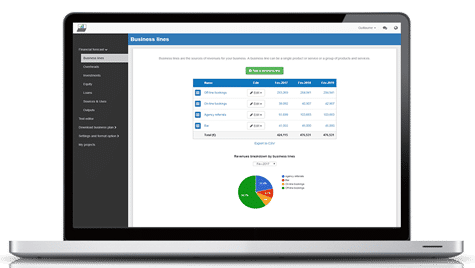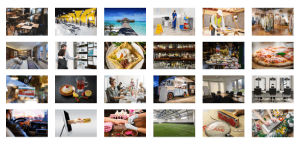How to create a financial forecast for a brand?
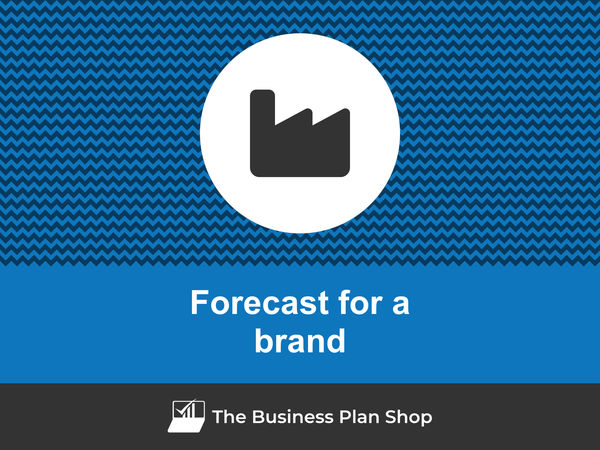
If you are serious about keeping visibility on your future cash flows, then you need to build and maintain a financial forecast for your brand.
Putting together a brand financial forecast may sound complex, but don’t worry, with the right tool, it’s easier than it looks, and The Business Plan Shop is here to guide you.
In this practical guide, we'll cover everything you need to know about building financial projections for your brand.
We will start by looking at why they are key, what information is needed, what a forecast looks like once completed, and what solutions you can use to create yours.
Let's dive in!
Why create and maintain a financial forecast for a brand?
Creating and maintaining an up-to-date financial forecast is the only way to steer the development of your brand and ensure that it can be financially viable in the years to come.
A financial plan for a brand enables you to look at your business in detail - from income to operating costs and investments - to evaluate its expected profitability and future cash flows.
This gives you the visibility needed to plan future investments and expansion with confidence.
And, when your trading environment gets tougher, having an up to date brand forecast enables you to detect potential upcoming financing shortfalls in advance, enabling you to make adjustments or secure financing before you run out of cash.
It’s also important to remember that your brand's financial forecast will be essential when looking for financing. You can be 100% certain that banks and investors will ask to see your numbers, so make sure they’re set out accurately and attractively.
Need a solid financial forecast?
The Business Plan Shop does the maths for you. Simply enter your revenues, costs and investments. Click save and our online tool builds a three-way forecast for you instantly.
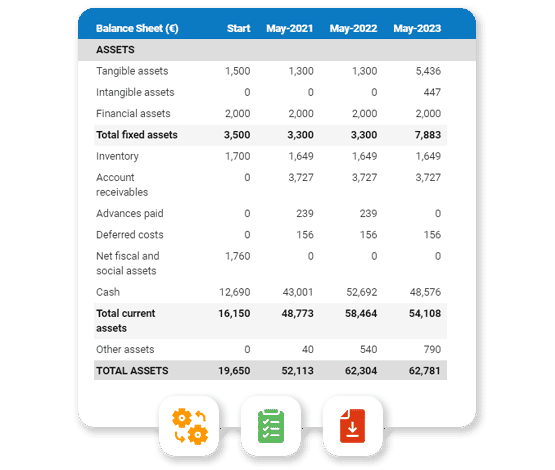
What information is used as input to build a brand financial forecast?
A brand's financial forecast needs to be built on the right foundation: your assumptions.
The data required to create your assumptions will depend on whether you are a new or existing brand.
If you are creating (or updating) the forecast of an existing brand, then your main inputs will be historical accounting data and operating metrics, and your team’s view on what to expect for the next three to five years.
If you are building financial projections for a new brand startup, you will need to rely on market research to form your go-to-market strategy and derive your sales forecast.
For a new venture, you will also need an itemised list of resources needed for the brand to operate, along with a list of equipment required to launch the venture (more on that below).
Now that you understand what is needed, let’s have a look at what elements will make up your brand's financial forecast.
The sales forecast for a brand
From experience, it usually makes sense to start your brand's financial projection with the revenues forecast.
The inputs used to forecast your sales will include the historical trading data of your brand (which can be used as a starting point for existing businesses) and the data collected in your market research (which both new ventures and existing businesses need to project their sales forward).
Your brand's sales forecast can be broken down into two key estimates:
- The average price
- The number of monthly transactions
To assess these variables accurately, you will need to consider the following factors:
- Seasonal demand: This factor refers to the fluctuation in demand for your brand's products based on the time of year. For example, if you sell winter clothing, sales may increase during the colder months and decrease during the summer.
- Competitor prices: The prices of your competitors can have a direct impact on your brand's average price. If your competitors lower their prices, you may need to adjust your prices accordingly to stay competitive.
- Product innovation: If your brand continuously introduces new and innovative products, it can drive up your average price and attract more customers. This can result in an increase in monthly transactions as customers are drawn to your brand's unique offerings.
- Economic conditions: Economic factors such as inflation, unemployment rates, and consumer confidence can affect the spending habits of your target market. During a recession, consumers may be more price-sensitive, resulting in a decrease in average price and monthly transactions for your brand.
- Brand reputation: Your brand's reputation can have a significant impact on both average price and monthly transactions. A positive reputation can command higher prices and attract more customers, while a negative reputation can drive prices down and discourage potential customers from purchasing from your brand.
Once you have a sales forecast in place, the next step will be to work on your overhead budget. Let’s have a look at that now.
Need inspiration for your business plan?
The Business Plan Shop has dozens of business plan templates that you can use to get a clear idea of what a complete business plan looks like.
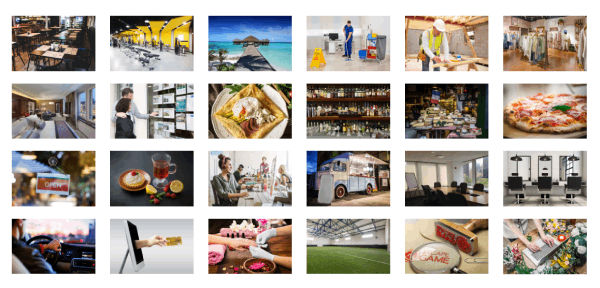
The operating expenses for a brand
Once you know what level of sales you can expect, you can start budgeting the expenses required to operate your brand on a daily basis.
Expenses normally vary based on how much revenue you anticipate (which is why, from experience, it is always better to start your forecast with the topline projection), and where your business is based.
Operating expenses for a brand will include some of the following items:
- Staff costs: Salaries, wages, and benefits for employees working on the brand, including marketing, sales, and customer service staff.
- Accountancy fees: Fees for professional accountants to handle financial and tax-related matters for the brand.
- Insurance costs: Premiums for various types of insurance coverage, such as liability insurance, property insurance, and business interruption insurance.
- Software licenses: Fees for using software programs and tools necessary for running the brand, such as accounting software, marketing automation tools, and project management software.
- Banking fees: Charges for various banking services, including transaction fees, wire transfer fees, and account maintenance fees.
- Marketing expenses: Costs for promoting the brand, such as advertising, public relations, and social media marketing.
- Sales commissions: Commissions paid to sales representatives or agents for generating sales for the brand.
- Travel expenses: Costs associated with business travel, such as airfare, hotel accommodations, and meals.
- Rent and utilities: Payments for office space, utilities, and other facilities used for operating the brand.
- Professional services: Fees for external services, such as legal advice, consulting services, and market research.
- Office supplies: Cost of purchasing and maintaining necessary office supplies, such as stationery, printers, and computers.
- Training and development: Expenses for employee training and development programs to improve skills and knowledge related to the brand.
- Inventory costs: Expenses for purchasing, storing, and managing inventory for the brand.
- Customer service costs: Expenses related to providing customer support, such as call center costs, software licenses for customer service tools, and training for customer service staff.
- Office equipment: Costs for purchasing and maintaining office equipment, such as furniture, printers, and copiers.
This list will need to be tailored to the specificities of your brand, but should offer a good starting point for your budget.
What investments are needed to start or grow a brand?
Creating and expanding a brand also requires investments which you need to factor into your financial forecast.
Capital expenditures and initial working capital items for a brand could include elements such as:
- Property and Equipment: This includes purchasing or leasing a physical location, such as a storefront or office space, as well as any necessary equipment for your brand, such as computers, furniture, and machinery.
- Inventory: Depending on your brand, you may need to invest in a certain amount of inventory to get started. This could include raw materials, finished products, or merchandise to sell.
- Technology: In today's digital age, investing in technology is crucial for any brand. This could include website development, e-commerce platforms, software, or hardware.
- Research and Development: As your brand grows, you may need to invest in research and development to stay competitive and continue improving your products or services. This could include hiring a research team or investing in new technology for product development.
- Intellectual Property: If your brand has unique trademarks, patents, or copyrights, you may need to invest in protecting them. This could include legal fees for trademark registration or patent filing.
Again, this list is not exhaustive and will need to be adjusted according to the circumstances of your brand.
Need a convincing business plan?
The Business Plan Shop makes it easy to create a financial forecast to assess the potential profitability of your projects, and write a business plan that’ll wow investors.
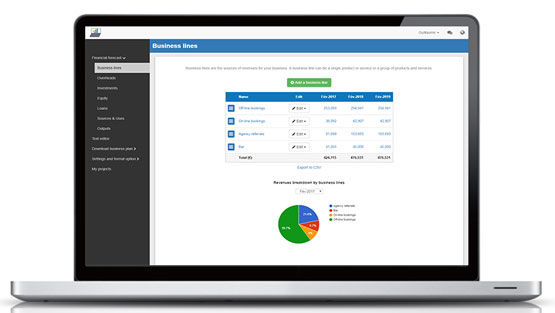
The financing plan of your brand
The next step in the creation of your financial forecast for your brand is to think about how you might finance your business.
You will have to assess how much capital will come from shareholders (equity) and how much can be secured through banks.
Bank loans will have to be modelled so that you can separate the interest expenses from the repayments of principal, and include all this data in your forecast.
Issuing share capital and obtaining a bank loan are two of the most common ways that entrepreneurs finance their businesses.
What tables compose the financial plan for a brand?
Now let's have a look at the main output tables of your brand's financial forecast.
The projected profit & loss statement
The projected profit & loss shows how profitable your brand is likely to be in the years to come.

For your brand to be financially viable, your projected P&L should ideally show:
- Sales growing above inflation (the higher the better)
- Profit margins which are stable or expanding (the higher the better)
- A net profit at the end of each financial year (the higher the better)
This is for established brands, there is some leniency for startups which will have numbers that will look a bit different than existing businesses.
The projected balance sheet
Your brand's forecasted balance sheet enables you to assess your financial structure and working capital requirements.
It is composed of three types of elements: assets, liabilities and equity:
- Assets: represent what the business owns and uses to produce cash flows. It includes resources such as cash, equipment, and accounts receivable (money owed by clients).
- Liabilities: represent funds advanced to the business by lenders and other creditors. It includes items such as accounts payable (money owed to suppliers), taxes due and loans.
- Equity: is the combination of what has been invested by the business owners and the cumulative profits and losses generated by the business to date (which are called retained earnings). Equity is a proxy for the value of the owner's stake in the business.

The cash flow forecast
Your brand's cash flow forecast shows how much cash your business is expected to consume or generate in the years to come.

It is best practice to organise the cash flow forecast by nature to better explain where cash is used or generated by the brand:
- Operating cash flow: shows how much cash is generated by the operating activities
- Investing cash flow: shows how much will be invested in capital expenditure to maintain or expand the business
- Financing cash flow: shows if the business is raising new capital or repaying financiers (debt repayment, dividends)
Keeping an eye on (and regularly updating) your brand's cash flow forecast is key to ensuring that your business has sufficient liquidity to operate normally and to detect financing requirements as early as possible.
If you are trying to raise capital, you will normally be asked to provide a monthly cash flow forecast in your brand's financial plan - so that banks or investors can assess seasonal variation and ensure your business is appropriately capitalised.
Need a solid financial forecast?
The Business Plan Shop does the maths for you. Simply enter your revenues, costs and investments. Click save and our online tool builds a three-way forecast for you instantly.

Which tool should you use to create your brand's financial forecast?
Creating your brand's financial forecast may sound fairly daunting, but the good news is that there are several ways to go about it.
Using online financial forecasting software to build your brand's projections
The modern and easiest way is to use professional online financial forecasting software such as the one we offer at The Business Plan Shop.
There are several advantages to using specialised software:
- You can easily create your financial forecast by letting the software take care of the financial calculations for you without errors
- You have access to complete financial forecast templates
- You get a complete financial forecast ready to be sent to your bank or investors
- You can easily track your actual financial performance against your financial forecast, and recalibrate your forecast as the year goes by
- You can create scenarios to stress test your forecast's main assumptions
- You can easily update your forecast as time goes by to maintain visibility on future cash flows
- You have a friendly support team on standby to assist you when you are stuck
- It’s cost-efficient and much cheaper than using an accountant or consultant (see below)
If you are interested in this type of solution, you can try our forecasting software for free by signing up here.
Calling in a financial consultant or chartered accountant
Enlisting the help of a consultant or accountant is also a good way to obtain a professional brand financial forecast.
The downside of this solution is its cost. From experience, obtaining a simple financial forecast over three years (including a balance sheet, income statement, and cash flow statement) is likely to cost a minimum of £700 or $1,000.
The indicative cost above, is for a small business, and a forecast is done as a one-shot exercise. Using a consultant or accountant to track your actuals vs. forecast and to keep your financial projections up to date on a monthly or quarterly basis will cost a lot more.
If you opt for this solution, make sure your accountant has in-depth knowledge of your industry, so that they may challenge your figures and offer insights (as opposed to just taking your assumptions at face value to create the forecast).
Why not use a spreadsheet such as Excel or Google Sheets to build your brand's financial forecast?
Creating an accurate and error-free brand financial forecast with a spreadsheet is very technical and requires a deep knowledge of accounting and an understanding of financial modelling.
Very few business owners are financially savvy enough to be able to build a forecast themselves on Excel without making mistakes.
Lenders and investors know this, which is why forecasts created on Excel by the business owner are often frowned upon.
Having numbers one can trust is key when it comes to financial forecasting and to that end using software is much safer.
Using financial forecasting software is also faster than using a spreadsheet, and, with the rise of artificial intelligence, software is also becoming smarter at helping us analyse the numbers to make smarter decisions.
Finally, like everything with spreadsheets, tracking actuals vs. forecasts and keeping your projections up to date as the year progresses is manual, tedious, and error-prone. Whereas financial projection software like The Business Plan Shop is built for this.
Need a convincing business plan?
The Business Plan Shop makes it easy to create a financial forecast to assess the potential profitability of your projects, and write a business plan that’ll wow investors.

Use our financial forecast templates for inspiration
The Business Plan Shop has dozens of financial forecast examples available.
Our templates contain both a financial forecast and a written business plan which presents, in detail, the company, the team, the strategy, and the medium-term objectives.
Our templates are a great source of inspiration, whether you just want to see what a complete business plan looks like, or are looking for concrete examples of how you should model financial elements in your own forecast.
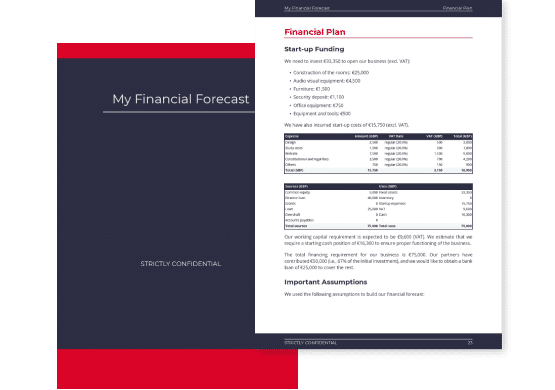
Takeaways
- A financial forecast shows expected growth, profitability, and cash generation metrics for your brand.
- Tracking actuals vs. forecast and having an up-to-date financial forecast is key to maintaining visibility on your future cash flows.
- Using financial forecasting software is the modern way of creating and maintaining financial projections.
We hope that this guide helped you gain a clearer perspective on the steps needed to create the financial forecast for a brand. Don't hesitate to contact us if you have any questions!
Need inspiration for your business plan?
The Business Plan Shop has dozens of business plan templates that you can use to get a clear idea of what a complete business plan looks like.

Also on The Business Plan Shop
Know someone who runs a brand? Share our business guide with them!

